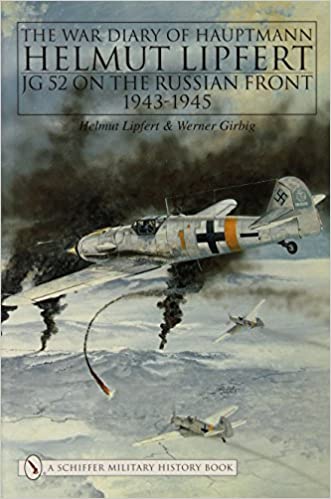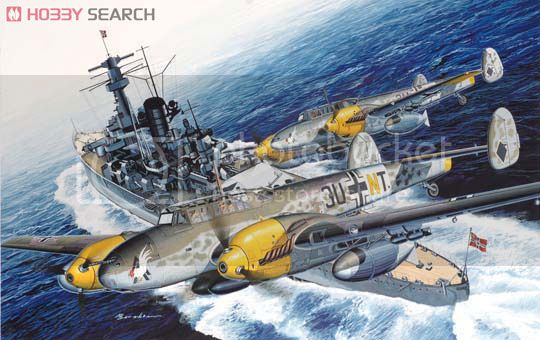I've got the Cyberhobby 1/48 BF 110D3. I'd really like to give it northern camo. There's a page on the LW in Norway, and according to it several units in Luftflotte 5 had BF110Ds: (Doesn't say which type of D)- 1 Group Zerstörergeschwader 76 is listed as having 20 110Ds. The D3 was a made for long range work and I'd think that quality would have suited Norwegian bases nicely. (Dragon did a 1/32 version of the 110D3 and the box art has a pair of planes flying over a German capital ship - and the ad info says many D3s flew over Norway. Anyway, the box couldn't have been portraying the Med where D3s were deployed.) Anyone know a source that I might consult on this matter?
Thanks in advance
Eric
World War II
Discuss WWII and the era directly before and after the war from 1935-1949.
Discuss WWII and the era directly before and after the war from 1935-1949.
Hosted by Rowan Baylis
BF 110D3s In Norway?
ebergerud

Joined: July 15, 2010
KitMaker: 297 posts
AeroScale: 76 posts

Posted: Monday, October 10, 2016 - 12:24 PM UTC
stooge

Joined: June 20, 2013
KitMaker: 210 posts
AeroScale: 210 posts

Posted: Tuesday, October 11, 2016 - 04:35 PM UTC
stooge

Joined: June 20, 2013
KitMaker: 210 posts
AeroScale: 210 posts

Posted: Wednesday, October 12, 2016 - 09:56 AM UTC
Also this is a side reference only, Lipfert flew 109s, but did tool about in 110s here and there.


ebergerud

Joined: July 15, 2010
KitMaker: 297 posts
AeroScale: 76 posts

Posted: Wednesday, October 12, 2016 - 10:50 AM UTC
Thanks much. Unfortunately the book won't be about until October 20. Here's the box art for Dragon's 1/32 BF110D3 - this has got to be northern waters. Luftflotte 5 had 110Ds in Norway - they may have escorted HE-111s on the debacle raid over northern England on August 15, 1940. However, according to the instructions the markings on the plane above would put them in ZG 26 which escorted over the Channel and then moved to the Med. Who can you trust?


Removed by original poster on 10/13/16 - 16:59:34 (GMT).
odybvig
Joined: June 03, 2007
KitMaker: 22 posts
AeroScale: 18 posts
KitMaker: 22 posts
AeroScale: 18 posts

Posted: Wednesday, October 12, 2016 - 10:00 PM UTC
The Bf 110 D-3 was mainly used by III./ZG 76 who arrived in Norway in november 1940 and left Norway march/april 1941. (the unit also used C and E models)
This photo show the typical colors of this unit.(taken in Norway) The Wespe emblem is not typical for the Norway periode, but seen on aircrafts before they left the country


Best from Norway
Olve Dybvig
This photo show the typical colors of this unit.(taken in Norway) The Wespe emblem is not typical for the Norway periode, but seen on aircrafts before they left the country


Best from Norway
Olve Dybvig
saint01

Joined: October 22, 2006
KitMaker: 7 posts
AeroScale: 3 posts
Posted: Thursday, October 13, 2016 - 02:09 AM UTC
You aren't necessarily limited to doing a D3. The Bf-110D allways had the lenghtened tail with the dinghy, period. The only difference between the -D variants was the ability, or lack thereoff, to carry the dackelbauch/bombs. And yes, I know google says otherwise. 
So you could portray the kit as a I./ZG 76 D1 on a local mission without the dackelbauch fitted (believe me, the crew only fitted these things when they really needed to). Or as Olve says, do a post BOB III./ZG 76 machine.
You could also do a early nightfighter, I've got pictures around somewhere of a detachment of Bf-110D's from NJG 1 that flew missions out of Norway.
Good sources are the Two Luftwaffe colours books on zerstorer by John Vasco and the German series "Die deutsche luftwaffe : eine bilddokumentation die zerstorer und nachtjagdverbande 1939-1945". There's also a book series called "JG 5 Eismeerjager", part 1 of which focuses on zerstorer operations in the North, unfortunately it doesn't offer much in the way of Bf-110D pictures.
Best regards,
Tony

So you could portray the kit as a I./ZG 76 D1 on a local mission without the dackelbauch fitted (believe me, the crew only fitted these things when they really needed to). Or as Olve says, do a post BOB III./ZG 76 machine.
You could also do a early nightfighter, I've got pictures around somewhere of a detachment of Bf-110D's from NJG 1 that flew missions out of Norway.
Good sources are the Two Luftwaffe colours books on zerstorer by John Vasco and the German series "Die deutsche luftwaffe : eine bilddokumentation die zerstorer und nachtjagdverbande 1939-1945". There's also a book series called "JG 5 Eismeerjager", part 1 of which focuses on zerstorer operations in the North, unfortunately it doesn't offer much in the way of Bf-110D pictures.
Best regards,
Tony
stonar

Joined: August 15, 2008
KitMaker: 337 posts
AeroScale: 309 posts

Posted: Saturday, October 15, 2016 - 10:12 PM UTC
Quoted Text
So you could portray the kit as a I./ZG 76 D1 on a local mission without the dackelbauch fitted (believe me, the crew only fitted these things when they really needed to).
Not really. The 'dackelbauch was a factory fitting and involved substtantial modifications. It could be removed for maintenance, but this didn't leave you with a clean Bf 110. The attchments stayed with the aircraft as did a fairing which was rivetted to the aircraft. Here is a picture of what you got when you removed the tanks and fairing.

You will find aircraft that have had the 'dackelbauch' removed, permanently. If you can find a good enough photograph of the relevant area of such an aircraft the traces of the rivets that held that fairing in place will be visible.
Cheers
Steve
saint01

Joined: October 22, 2006
KitMaker: 7 posts
AeroScale: 3 posts
Posted: Sunday, October 16, 2016 - 01:19 AM UTC
Quoted Text
Quoted Text
So you could portray the kit as a I./ZG 76 D1 on a local mission without the dackelbauch fitted (believe me, the crew only fitted these things when they really needed to).
Not really. The 'dackelbauch was a factory fitting and involved substtantial modifications. It could be removed for maintenance, but this didn't leave you with a clean Bf 110. The attchments stayed with the aircraft as did a fairing which was rivetted to the aircraft. Here is a picture of what you got when you removed the tanks and fairing.
You will find aircraft that have had the 'dackelbauch' removed, permanently. If you can find a good enough photograph of the relevant area of such an aircraft the traces of the rivets that held that fairing in place will be visible.
Cheers
Steve
True and not true.
It is correct that a portion of Bf-110D production was being delivered with the dackelbauch fitted, but you are making the switch between configurations sound more than it really was. The fuselage fairing was screwed in place, not riveted, and the whole concept had allways been designed with the easy change between two distinct configurations - "rustzustand 1" (dackelbauch + 2 optional 900L wing drop tanks) and "rustzustand 2" (fuselage mounted oil drop tank + 2 900L wing drop tanks) - in mind. For clarity : Rz 2 involved returning the aircraft to " clean" configuration. The Bf-110D-0 manual details the work needed to remove the dackelbauch including fairing, and it takes just 7 steps. This could have easily been accomplished by a field maintenance unit in a short period of time. As is also proven by pictoral and written (generalluftzeugmeister notes from september 1940) evidence of units actively removing the dackelbauch in the field.
Now if you want bulletproof confirmation of a I./ZG 76 Bf-110D in Norway without the dackelbauch fitted, then I will freely admit that I cannot offer that. Unfortunately pictures of the unit's time there remain scarce. On the other hand I see nothing to suggest that it was impossible. Lack of need during shorter range patrols, the dackelbauch's detrimental effects on performance and handling and the unit's disastrous experiences with it during their one raid against England make it seem like a reasonable possibility in fact.
As for the model, I'm not so shre the screw holes were allways freshly touched up with paint as in the well known pictures of the erprobungsgruppe 210 example, but if it bothers the modeler in question the bolt holes and covers for the fuel lines and electrical connectors should be easy enough to add.
Best regards,
Tony
ebergerud

Joined: July 15, 2010
KitMaker: 297 posts
AeroScale: 76 posts

Posted: Sunday, October 16, 2016 - 02:52 AM UTC
I'm puzzled by the box art for the Dragon 110D3 kit shown above. After looking at a few zillion photos, I was able to identify the AC as belonging to .9/ZG26. As you can see the planes are flying over a German capital ship - a heavy cruiser I'd guess. So that can't be in the Med - unless the Kriegsmarine was able to do a badly documented but miraculous "Channel dash" past Gibralter or Suez. (I rather doubt that - but it could explain Admiral Pound's sudden death in 1943 - Churchill might have shot him.) ZG26 did escort and jabo attacks on England during the BoB, but judging by the location of bases, they wouldn't have been near a German warship. G I & III had 110Ds in 1939 and they did fly "home defense" during the 1939 and did intercept some RAF bombing raids aimed at KM targets in the North Sea. The kit's instructions have the boxart plane as a decal option, but it is simply listed as .9/ZG26 with no location given. Now a sane person would simply use one of the ZG26 schemes give in the instructions and hell with Norway. But now it's a matter of principle.
Eric
Eric
saint01

Joined: October 22, 2006
KitMaker: 7 posts
AeroScale: 3 posts
Posted: Monday, October 17, 2016 - 01:02 AM UTC
Eric,
I'm pretty certain the boxart is fictional. Both the -D variant as well as the camouflage scheme -with the RLM 02 mottle high up the fuselage- and markings suggest a timing of around the BOB at the earliest.
The ship's secondary armament points to the artist trying to depict a Deutschland class "pocket battleship", no member of which got close to the action of the BOB or ever ventured into the meditteranean -as did none of the other major kriegsmarine surface combatants in fact.
That would leave just the small window in between the BOB and ZG 26's deployment to the med when they spent some time reforming in Germany and where one could possibly imagine them doing some escort work over the North sea or the Baltic. However, as far as I've been able to determine all three ZG 26 gruppen were deployed in Bavaria during that time, a long way from any seas... .
I'm pretty certain the boxart is fictional. Both the -D variant as well as the camouflage scheme -with the RLM 02 mottle high up the fuselage- and markings suggest a timing of around the BOB at the earliest.
The ship's secondary armament points to the artist trying to depict a Deutschland class "pocket battleship", no member of which got close to the action of the BOB or ever ventured into the meditteranean -as did none of the other major kriegsmarine surface combatants in fact.
That would leave just the small window in between the BOB and ZG 26's deployment to the med when they spent some time reforming in Germany and where one could possibly imagine them doing some escort work over the North sea or the Baltic. However, as far as I've been able to determine all three ZG 26 gruppen were deployed in Bavaria during that time, a long way from any seas... .
 |







